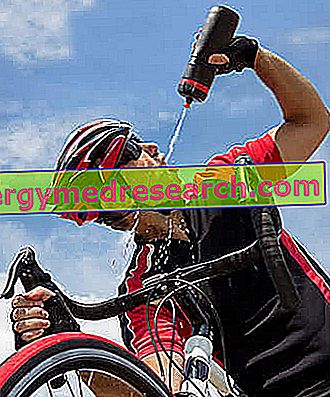Introduction
The body of a human being contains more than 50% water (up to 75% in the body of the baby child).
Fluids are found inside the cells and outside them (extracellular spaces), where they perform numerous biologically important functions; among these, the functions of:
- Transport (blood and lymph).
- Temperature control.
- Digestion.

The latter occurs when fluid losses (through urine, faeces, sweat, etc.) exceed the introduction (generally provided by food and drinks).
The state of hydration is strongly related to the saline balance; not by chance, the alterations of these two elements (for quantity and proportion) are defined as hydro-saline imbalances.
Hydration is essential for maintaining the health of cells, tissues, organs, etc. Dehydration causes a loss of psycho-physical efficiency and even serious complications.
To counteract dehydration it is essential to listen to the stimulus of thirst and to eat properly.
Hydration in Cycling
Physical activity, especially intense sports, is responsible for the production of heat and the consequent sweating, or the cutaneous loss of water and small amounts of mineral salts.
Sports sweating is a very personal factor; it is solicited differently depending on: intensity of exercise, duration of effort, clothing, type of sport, environment, acclimatization and other factors.
Cycling is an activity that can easily cause dehydration. In fact, in addition to being characterized by very long training sessions, it exposes the subject to drafts that quickly make the sweat evaporate and dry the skin.
How can dehydration be avoided in the cyclist?
Prevent Dehydration
The first trick to follow to avoid dehydration in cycling is prevention.
- Clothing: choosing technical garments is a valid aid to reduce sweat losses. In fact, certain clothes cover the skin protecting it from the sun's rays and preventing the convective action of the wind. At the same time, they let the sweat evaporate, preventing it from accumulating. The thermal seal level must be appropriate for the season.
- Hours: it is advisable to train in the cooler hours. The morning temperature can be as low as 10 ° C compared to the afternoon and triggers a less pronounced sweating.
- Drinking and eating: cycling is an activity that allows you to carry both food and drink. Many sportsmen tend to drink only after the onset of thirst, but it is a wrong behavior. Sometimes the thirst stimulus delays or is not clearly felt (due to endorphins, distraction, etc.). Furthermore, thirst arises only after the loss of fluids, while it would be necessary to drink before the organism goes "in crisis".
Unlike the race, in cycling there is little "bottic effect", or the "tossing" of liquids in the stomach caused by body movements. However, several people report a tendency to reflux and regurgitation caused by the prone position.
This can be avoided by drinking a little at a time and choosing an easily absorbable beverage (see below).
The most absorbable drink
Let's start off by dispelling a widespread belief that water represents the best absorbable drink.
Water has an extremely hypotonic osmotic concentration, while the mucous membranes of the digestive system more easily absorb isotonic liquids (with the same concentration of physiological liquids) or slightly hypotonic.
What should the cyclist's drink contain?
Chemical composition
The necessary solutes for the moisturizing drink are: sodium, potassium, magnesium, chlorine, carbohydrates (monosaccharides, disaccharides and maltodextrins), some acids and some vitamins.
Some sportsmen consider the use of supplements a useless and unnecessary behavior, sometimes unnatural. On the other hand, tackling 6-10 hours of cycling a week requires a very high metabolic effort that can be supported by the intake of salt and water supplements.
Let me be clear, no synthetic product can replace the diet; on the other hand, "nutritional help" can be very useful for:
- Ensure hydration.
- Improve recovery.
- Avoid saline deficiencies.
All this with the advantage of selectively introducing the necessary molecules, avoiding unwanted or excess compounds.
For example, to increase the intake of potassium and magnesium with the diet it would be necessary to increase fruit, vegetables, whole grains and legumes. On the other hand, these are also rich in carbohydrates, fiber, phytic acid, oxalic acid, etc.
Temperature
Another determining factor to optimize the absorption of the drink is the temperature. The liquid must absolutely not be hot or at room temperature, but cooler as possible (not frozen).
It is advisable to seek the right temperature gradually to avoid the onset of cramps, vomiting, diarrhea, etc.
Portability of Beverage
As anticipated, cycling is not a discipline that presents the inconvenience of transporting beverages.
This is especially true in training, when one or two kilograms of extra weight makes no difference.
On the other hand, we remember that:
- It is advisable to use thermal water bottles.
- The bicycle bottle cage cannot accommodate containers that are too large, so it is advisable to install at least two or to provide a bottle cage with a pouch or shoulder strap.
After training?
Drinking after training is essential, even if it represents only 30-35% of the total amount of liquid to be replenished.
Also in this phase it is advisable to prefer a food supplement. In fact, restoring the reserves of water, salts and carbohydrates is an indispensable aspect of optimal recovery (supercompensation).
The first hour following the athletic effort is the most important one (especially the first 15 minutes), as the body has a greater sensitivity for absorption and metabolization of nutrients.
By anticipating the absorption and metabolization of the elements to be restored, recovery can be speeded up. It must always be kept in mind that, after absorption, the nutrients do not reach the tissues with the same speed as the water; sometimes it takes many hours. Moreover, let us not forget that intestinal absorption never reaches 100%.
Choosing a good hydrosaline supplement to combine and alternate with water is certainly the best strategy.
Quantity: Better to Abound?
The right amount of water and supplement is a subjective factor.
Respecting the sensation of thirst, it is advisable to try to reintroduce at least 1.5 liters of liquid for every hour of activity carried out at medium temperature. With higher temperatures it would be advisable to reach 2.0-2.5 liters to be divided before, during and after the performance.
Losing 2-3% of body weight in liquids causes a decline in mental and physical performance.
The most correct way to understand how much to drink is by carrying out double weighing. By detecting body weight before and after the session, making the difference, it is possible to understand the approximate amount of sweating.
This value represents a very useful trace that must be used in the workouts to be played later, provided they are in similar conditions.



